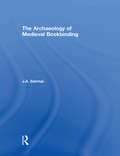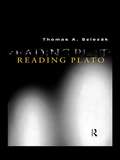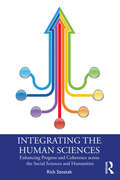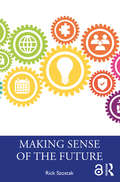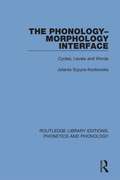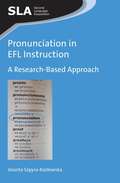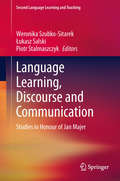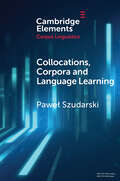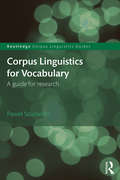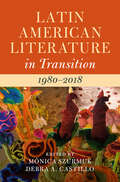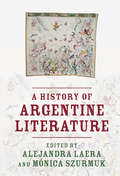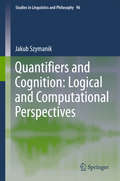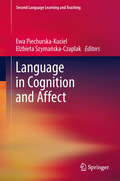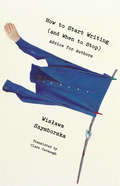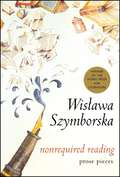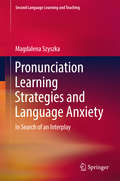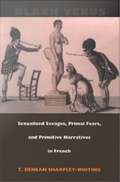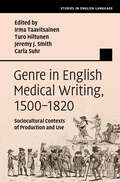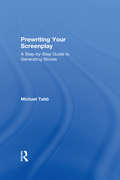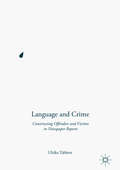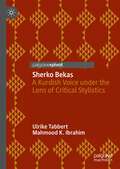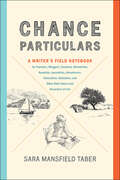- Table View
- List View
The Trident Tragedy
by Robert J. Szilagye Stanley MonroeAMERICA'S MOST AWESOME NUCLEAR WEAPON-IT RETURNED FROM ITS MAIDEN VOYAGE AS FLAWLESS AS IT HAD LEFT-WITH EVERY MAN ABOARD DEAD.... A HANDPICKED CREW One hundred sixty-one men-proud officers and crew-on the test voyage of a submarine unlike any other in the world. They knew their ship. They knew their duty. But they never suspected their fate. A MYSTERIOUS DISASTER What had happened aboard the U.S.S. Trident? Why had it been found with every man lying dead at his station? Was it a freak accident? Criminal negligence? Or was it sabotage? TWO RELENTLESS INVESTIGATORS One was a female reporter who hated the Navy. The other was a Naval Intelligence officer who mistrusted the press. Separately, they were getting nowhere. Together, they were uncovering just enough to get themselves killed. And should they perish, who would be left to uncover the stunning truth behind ....
The Archaeology of Medieval Bookbinding
by J.A. SzirmaiIn the past, studies of the history of bookbinding were mainly concerned with the exterior decoration. This book focuses attention primarily on the physical aspects of the binding and its construction principles. It is an expanded version of a series of lectures delivered by the author while Visiting Professor at the University of Amsterdam in 1987, supplemented with the results of ten years of intensive research in major libraries on the Continent, the United Kingdom and the USA. It surveys the evolution of binding structures from the introduction of the codex two thousand years ago to the close of the Middle Ages. Part I reviews the scanty physical evidence from the Mediterranean heritage, the early Coptic, Islamic and Ethiopian binding structures and their interrelation with those of the Byzantine realm. Part II is devoted to a detailed analysis of Western binding techniques, distinguishing the carolingian, romanesque and gothic wooden-board bindings as the main typological entities; their structure and function is compared with those of contemporary limp bindings. The book is illustrated with over 200 drawings and photographs and contains a comprehensive bibliography.
Reading Plato
by Thomas A. SzlezákReading Plato offers a concise and illuminating insight into the complexities and difficulties of the Platonic dialogues, providing an invaluable text for any student of Plato's philosophy.Taking as a starting point the critique of writing in the Phaedrus -- where Socrates argues that a book cannot choose its reader nor can it defend itself against misinterpretation -- Reading Plato offers solutions to the problems of interpreting the dialogues. In this ground-breaking book, Thomas A. Szlezak persuasively argues that the dialogues are designed to stimulate philosophical enquiry and to elevate philosophy to the realm of oral dialectic.
Grammatical Variation in British English Dialects
by Benedikt SzmrecsanyiVariation within the English language is a vast research area, of which dialectology, the study of geographic variation, is a significant part. This book explores grammatical differences between British English dialects, drawing on authentic speech data collected in over 30 counties. In doing so it presents a new approach known as 'corpus-based dialectometry', which focuses on the joint quantitative measurement of dozens of grammatical features to gauge regional differences. These features include, for example, multiple negation (e. g. don't you make no damn mistake), non-standard verbal-s (e. g. so I says, What have you to do?), or non-standard weak past tense and past participle forms (e. g. they knowed all about these things). Utilizing state-of-the-art dialectometrical analysis and visualization techniques, the book is original both in terms of its fundamental research question ('What are the large-scale patterns of grammatical variability in British English dialects?') and in terms of its methodology.
Integrating the Human Sciences: Enhancing Progress and Coherence across the Social Sciences and Humanities
by Rick SzostakWhat if we recognized that the human sciences collectively investigate a few dozen key phenomena that interact with each other? Can we imagine a human science that would seek to stitch its understandings of this system of phenomena into a coherent whole? If so, what would that look like? This book argues that we are unlikely to develop one unified "theory of everything." Our collective understanding must then be a "map" of the myriad relationships within this large – but finite and manageable – system, coupled with detailed understandings of each causal link and of important subsystems. The book outlines such a map and shows that the pursuit of coherence – and a more successful human science enterprise – requires integration, recognizing the strengths and weaknesses of different methods and theory types, and the pursuit of terminological and presentational clarity. It explores how these inter-connected goals can be achieved in research, teaching, library classification, public policy, and university administration. These suggestions are congruent with, and yet enhance, other projects for reform of the human sciences. This volume is aimed at any scholar or student who seeks to comprehend how what they study fits within a broader understanding.
Making Sense of the Future
by Rick SzostakMaking Sense of the Future integrates the latest thinking in Future Studies with the author’s expertise in world history, economics, interdisciplinary studies, knowledge organization, and political activism. The book takes a systems approach that recognizes the complexity of our world. It begins by suggesting a set of goals for human societies and identifying innovative strategies for achieving these goals that could gain broad support. Each chapter begins with a “How to” section that discusses how we can identify goals, strategies, trends, surprises, or implementation strategies and concludes with an integrative analysis that draws connections across the preceding discussions. Taking a cross-disciplinary approach, Szostak explores key trends and how these interact so that he can develop strategies to guide trends towards desirable futures. He discusses the ways in which we can best prepare for surprises such as epidemics and natural disasters, enabling us to react to them in beneficial ways. Supported by a list of guiding questions and suggestions for class projects, this is an accessible textbook for students of Future Studies and Future Studies courses.
The Phonology-Morphology Interface: Cycles, Levels and Words (Routledge Library Editions: Phonetics and Phonology #22)
by Jolanta Szpyra-KozłowskaFirst published in 1989. The development of morphological and phonological theory within the broad framework of generative grammar poses a number of important questions concerning the mutual relationship of phonology and morphology. This study aims to answer these questions. On the basis of Polish and English language material, the author examines the most important aspects of phonology-morphology interaction, and suggests the best model with which to describe these phenomena.
Pronunciation in EFL Instruction
by Jolanta Szpyra-KozłowskaIn view of recent debates on the global spread of English and its international lingua franca role, what pronunciation models are appropriate for millions of EFL learners? Which aspects of English phonetics should be taught to foreign students and which can be neglected with little loss to successful communication? How can English pronunciation be taught in an interesting and effective way which is both learner- and teacher-friendly, in accordance with the latest scholarly and technological achievements? This research-based book addresses these and many other fundamental issues that are currently at the centre of pronunciation teaching. It offers a wealth of new theoretical ideas and practical solutions to various phonodidactic problems that arise in EFL contexts, approaching pronunciation instruction from global and local perspectives and supporting its theoretical claims with extensive empirical evidence. It will be of interest to EFL teachers and teacher trainers, pronunciation specialists and students of applied linguistics.
Multilingual Lexical Recognition in the Mental Lexicon of Third Language Users
by Weronika Szubko-SitarekThe monograph constitutes an attempt to demonstrate that trilinguals should be considered as learners and speakers in their own right as opposed to L2 learners with a view to enumerating consequences this would bring to third or additional language teaching. Its theoretical part offers an insight into the structure of the multilingual mental lexicon which is a product of the interplay of a whole array of cross-linguistic factors in the minds of multilingual speakers. The empirical part reports the findings of an empirical study which aimed to investigate connections which are formed between multiple languages in a multilingual mind. All the aspects, analyzed in the experiments are part of a broader question of how multilinguals make their lexical decisions and, more specifically, how they recognize words from different languages. The book closes with the discussion of the role of the obtained results for multilingual didactics as well as some possible areas for future research.
Language Learning, Discourse and Communication
by Weronika Szubko-Sitarek Łukasz Salski Piotr StalmaszczykThis volume brings together papers on a wide spectrum of topics within the broad area of language acquisition, stressing the interconnections between applied and theoretical linguistics, as well as language research methodology. These contributions in honor of Professor Jan Majer have been grouped in two sections: language learning, and discourse and communication. The former discusses issues varying from aspects of first, second, and third language acquisition, individual learner differences (i. e. gender, attitudes, learning strategies), and second language research methodology to the analysis of features of learner spoken language, the role of feedback in foreign language instruction, and the position of culture in EFL textbooks. The second part of the volume offers a theoretical counterbalance to the applied nature of the first one. Here, the contributions touch upon spoken and written language analysis, language awareness, and aspects of the English language; also, selected issues of language philosophy are discussed. The wide range of topics covered in the publication, authored by specialists in their respective areas, reflects Professor Majer's academic interests and corresponds to the complex nature of the general field the volume aims to portray.
Collocations, Corpora and Language Learning (Elements in Corpus Linguistics)
by Paweł SzudarskiThis Element provides a systematic overview and synthesis of corpus-based research into collocations focusing on the learning and use of collocations by second language (L2) users. Underlining the importance of collocation as a key notion within the field of corpus linguistics, the text offers a state-of-the-art account of the main findings related to the applications of corpora and corpus-based measures for defining, identifying and analysing collocations as related to second language acquisition. Emphasising the quality of L2 collocation research, the Element illustrates key methodological issues to be considered when conducting this type of corpus analysis. It also discusses examples of pertinent research questions and points to representative studies treated as models of good practice. Aiming at researchers both new and experienced, the Element also points to avenues for future work and shows the relevance of corpus-based analysis for improving the process of learning and teaching of L2 collocations.
Corpus Linguistics for Vocabulary: A Guide for Research (Routledge Corpus Linguistics Guides)
by Paweł SzudarskiCorpus Linguistics for Vocabulary provides a practical introduction to using corpus linguistics in vocabulary studies. Using freely available corpus tools, the author provides a step-by-step guide on how corpora can be used to explore key vocabulary-related research questions and topics such as: The frequency of English words and how to choose which ones should be taught to learners; How spoken vocabulary differs from written vocabulary, and how academic vocabulary differs from general vocabulary; How vocabulary contributes to the structure of discourse, and the pragmatic functions it fulfils. Featuring case studies and tasks throughout, Corpus Linguistics for Vocabulary provides a clear and accessible guide and is essential reading for students and teachers wanting to understand, appreciate and conduct corpus-based research in vocabulary studies.
Latin American Literature in Transition 1980–2018: Volume 5 (Latin American Literature in Transition)
by Mónica Szurmuk Debra A. CastilloHow do we address the idea of the literary now at the end of the second decade in the 21st century? Many traditional categories obscure or overlook significant contemporary forms of cultural production. This volume looks at literature and culture in general in this hinge period. Latin American Literature in Transition 1980-2018 examines the ways literary culture complicates national or area studies understandings of cultural production. Topics point to fresh, intersectional understandings of cultural practice, while keeping in mind the ongoing stakes in a struggle over material and intangible cultural and political borders that are being reinforced in formidable ways.
A History of Argentine Literature
by Mónica Szurmuk Alejandra LaeraArgentine Literature continues to figure prominently in academic programs in the English-speaking world, and it has an increasing presence in English translation in international prizes and trade journals. A History of Argentine Literature proposes a major reimagining of Argentine literature attentive to production in indigenous and migration languages and to current debates in Literary Studies. Panoramic in scope and incisive in its in-depth studies of authors, works, and theoretical problems, this volume builds on available scholarship on canonical works but opens up the field to include a more diverse rendering as well as engaging with the full spectrum of textual interventions from travel writing to drama, from popular 'gauchesca' to celebrated avant guard works Working at the crossroads of disciplines, languages and critical traditions, this book accounts for the wealth of Argentine cultural production and maps the rich, diverse and often overlooked history of Argentine literature.
Quantifiers and Cognition: Logical and Computational Perspectives
by Jakub SzymanikThis volume on the semantic complexity of natural language explores the question why some sentences are more difficult than others. While doing so, it lays the groundwork for extending semantic theory with computational and cognitive aspects by combining linguistics and logic with computations and cognition. Quantifier expressions occur whenever we describe the world and communicate about it. Generalized quantifier theory is therefore one of the basic tools of linguistics today, studying the possible meanings and the inferential power of quantifier expressions by logical means. The classic version was developed in the 1980s, at the interface of linguistics, mathematics and philosophy. Before this volume, advances in "classic" generalized quantifier theory mainly focused on logical questions and their applications to linguistics, this volume adds a computational component, the third pillar of language use and logical activity. This book is essential reading for researchers in linguistics, philosophy, cognitive science, logic, AI, and computer science.
Language in Cognition and Affect
by Elżbieta Szymańska-Czaplak Ewa Piechurska-KucielThe volume contains most updated theoretical and empirical research on foreign or second language processes analyzed from the perspective of cognition and affect. It consists of articles devoted to various issued related to such broad topics as gender, literacy, translation or culture, to mention a few. The collection of papers offers a constructive and inspiring insight into a fuller understanding of the interconnection of the language-cognition-affect trichotomy.
How to Start Writing (and When to Stop): Advice for Writers
by Wislawa SzymborskaAt once kind and hilarious, this compilation of the Nobel Prize-winning poet’s advice to writers is illustrated with her own marvelous collages In this witty “how-to” guide, Wislawa Szymborska has nothing but sympathy for the labors of would-be writers generally: “I myself started out with rotten poetry and stories,” she confesses in this collection of pieces culled from the advice she gave—anonymously—for many years in the well-known Polish journal Literary Life. She returns time and again to the mundane business of writing poetry properly, that is to say, painstakingly and sparingly. “I sigh to be a poet,” Miss A. P. from Bialogard exclaims. “I groan to be an editor,” Szymborska responds. Szymborska stubbornly insists on poetry’s “prosaic side”: “Let’s take the wings off and try writing on foot, shall we?” This delightful compilation, translated by the peerless Clare Cavanagh, will delight readers and writers alike. Perhaps you could learn to love in prose.
Nonrequired Reading
by Wislawa Szymborska Clare CavanaghWislawa Szymborska's poems are admired around the world, and her unsparing vision, tireless wit, and deep sense of humanity are cherished by countless readers. Unknown to most of them, however, Szymborska also worked for several decades as a columnist, reviewing a wide variety of books under the unassuming title "Nonrequired Reading." As readers of her poems would expect, the short prose pieces collected here are anything but ordinary. Reflecting the author's own eclectic tastes and interests, the pretexts for these ruminations range from books on wallpapering, cooking, gardening, and yoga, to more lofty volumes on opera and world literature. Unpretentious yet incisive, these charming pieces are on a par with Szymborska's finest lyrics, tackling the same large and small questions with a wonderful curiosity.
Pronunciation Learning Strategies and Language Anxiety
by Magdalena SzyszkaThis book presents theoretical considerations and the results of empirical research on pronunciation learning strategies (PLS) deployed by pre-service trainee teachers majoring in English as a foreign language who experienced different levels of language anxiety (LA). The theoretical part focuses on the concepts of pronunciation learning, pronunciation-learning strategies and language anxiety and includes an overview of recent empirical research dealing with various related issues. The empirical section of the book presents the findings of a research project that investigated the interplay between PLS and LA, in which both quantitative and qualitative data were collected. Based on the findings, the author proposes two profiles of anxious and non-anxious EFL trainee teachers who support their pronunciation learning with an array of pronunciation learning strategies and tactics.
Black Venus: Sexualized Savages, Primal Fears, and Primitive Narratives in French
by T. Denean Sharpley-WhitingBlack Venus is a feminist study of the representations of black women in the literary, cultural, and scientific imagination of nineteenth-century France. Employing psychoanalysis, feminist film theory, and the critical race theory articulated in the works of Frantz Fanon and Toni Morrison, T. Denean Sharpley-Whiting argues that black women historically invoked both desire and primal fear in French men. By inspiring repulsion, attraction, and anxiety, they gave rise in the nineteenth-century French male imagination to the primitive narrative of Black Venus. The book opens with an exploration of scientific discourse on black females, using Sarah Bartmann, the so-called Hottentot Venus, and natural scientist Georges Cuvier as points of departure. To further show how the image of a savage was projected onto the bodies of black women, Sharpley-Whiting moves into popular culture with an analysis of an 1814 vaudeville caricature of Bartmann, then shifts onto the terrain of canonical French literature and colonial cinema, exploring the representation of black women by Baudelaire, Balzac, Zola, Maupassant, and Loti. After venturing into twentieth-century film with an analysis of Josephine Baker's popular Princesse Tam Tam, the study concludes with a discussion of how black Francophone women writers and activists countered stereotypical representations of black female bodies during this period. A first-time translation of the vaudeville show The Hottentot Venus, or Hatred of Frenchwomen supplements this critique of the French male gaze of the nineteenth and early twentieth centuries. Both intellectually rigorous and culturally intriguing, this study will appeal to students and scholars in the fields of nineteenth- and twentieth-century French literature, feminist and gender studies, black studies, and cultural studies.
Genre in English Medical Writing, 1500–1820: Sociocultural Contexts of Production and Use (Studies in English Language)
by Irma Taavitsainen Turo Hiltunen Jeremy J. Smith Carla SuhrWritten by an interdisciplinary team of scholars, this book offers novel perspectives on the history of medical writing and scientific thought-styles by examining patterns of change and reception in genres, discourse, and lexis in the period 1500-1820. Each chapter demonstrates in detail how changing textual forms were closely tied to major multi-faceted social developments: industrialisation, urbanisation, expanding trade, colonialization, and changes in communication, all of which posed new demands on medical care. It then shows how these developments were reflected in a range of medical discourses, such as bills of mortality, medical advertisements, medical recipes, and medical rhetoric, and provides an extensive body of case studies to highlight how varieties of medical discourse have been targeted at different audiences over time. It draws on a wide range of methodological frameworks and is accompanied by numerous relevant illustrations, making it essential reading for academic researchers and students across the human sciences.
Prewriting Your Screenplay: A Step-by-Step Guide to Generating Stories
by Michael TabbPrewriting Your Screenplay cements all the bricks of a story’s foundations together and forms a single, organic story-growing technique, starting with a blank slate. It shows writers how to design each element so that they perfectly interlock together like pieces of a puzzle, creating a stronger story foundation that does not leave gaps and holes for readers to find. This construction process is performed one piece at a time, one character at a time, building and incorporating each element into the whole. The book provides a clear-cut set of lessons that teaches how to construct that story base around concepts as individual as the writer’s personal opinions, helping to foster an individual writer’s voice. It also features end-of-chapter exercises that offer step-by-step guidance in applying each lesson, providing screenwriters with a concrete approach to building a strong foundation for a screenplay. This is the quintessential book for all writers taking their first steps towards developing a screenplay from nothing, getting them over that first monumental hump, resulting in a well-formulated story concept that is cohesive and professional.
Language and Crime
by Ulrike TabbertThis book offers a systematic introduction to the linguistic analysis of newspaper reports on crime. The author demonstrates how the linguistic analysis of newspaper texts helps to gain insight into the construction of offenders and victims in those texts and links the findings to criminological frameworks. Tabbert employs Critical Stylistics to explore the description of participants, the presentation of speech as well as actions, states or events, and other linguistic devices employed by journalists to present a particular image of an offender or a victim in the press. This book shows the fruitfulness of an interdisciplinary approach to reveal predominant discourse on crime in society and will be of great interest to researchers in linguistics, criminology and media studies.
Sherko Bekas: A Kurdish Voice under the Lens of Critical Stylistics
by Ulrike Tabbert Mahmood K. IbrahimThis book explores poetry by Sherko Bekas, a Kurdish writer and Swedish Tucholsky award winner, providing contextualising biography (with original new information from an interview with his son) and critical stylistic analyses of two selected poems. The authors also include a section on the Kurdish language and translation of the poems into English. There are very few English translations of some of Bekas' poems and no book so far on the stylistic or even linguistic analysis of his work, with the result that Bekas is not widely known in the "Western" world. This book aims to fill this lacuna in the literary and linguistic canon, and it will be of interest to students and scholars of Translation, Stylistics, Middle Eastern History and Literature.
Chance Particulars: A Writer's Field Notebook for Travelers, Bloggers, Essayists, Memoirists, Novelists, Journalists, Adventurers, Naturalists, Sketchers, and Other Note-Takers and Recorders of Life
by Sara Mansfield TaberAn essential guide for writers on how to record and use rich detail to enliven their work.The goal of the writer is to live with the keenness of the foreigner. To experience, wide-eyed, the sensations aroused and the events offered up by peculiar surrounds and then to evoke them so brightly on the page that the reader, too, experiences the foreigner’s frisson. A time-honored way this is accomplished is through the keeping of a field notebook—through the faithful recording of the this-and-that of life; the atmospheres and incidents; the bells, the beer, the bread.Based on what accomplished nonfiction writer Sara Mansfield Taber learned in her many years of field notebook keeping, Chance Particulars is a unique and handy primer for writers who want to use their experiences to tell a lively, satisfying story. Often, writers try to turn their notes into a memoir, essay, travel piece, or story, only to find that they haven’t recorded enough of the concrete, sensory details necessary to create evocative description. To help writers overcome this problem, Taber has composed a true "field notebook for field notebook keepers." Enhanced by beautiful illustrations, this charming and comprehensive guide is a practical manual for anyone who wishes to learn or hone the crafts of writing, ethnography, or journalism.Writers of all levels, genres, and ages, as well as teachers of writing, will appreciate this useful tool for learning how to record the details that build vibrant prose. With this book in hand, you will be able to recreate times and places, conjure up intricate character portraits, and paint pictures of particular landscapes, cultures, and locales.

